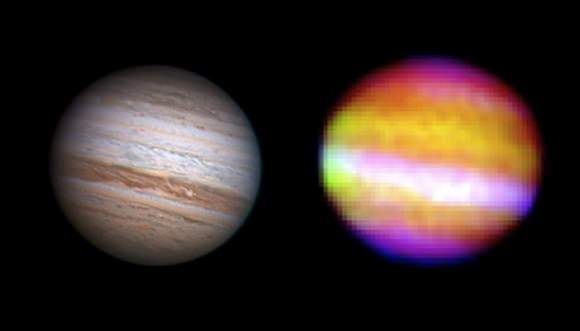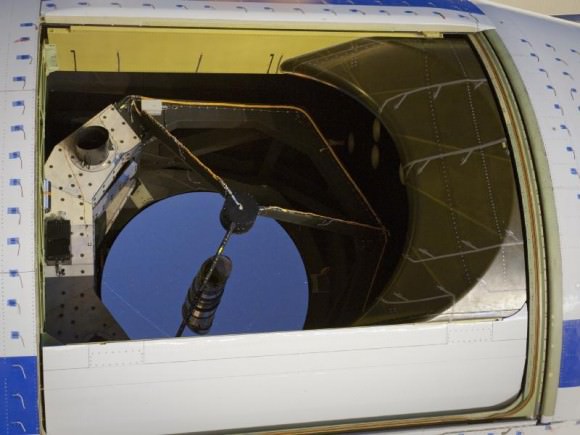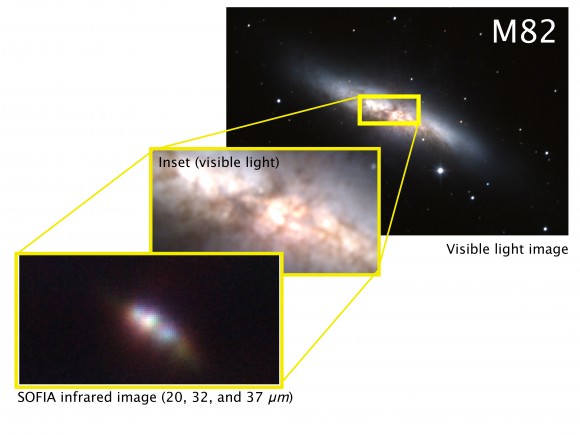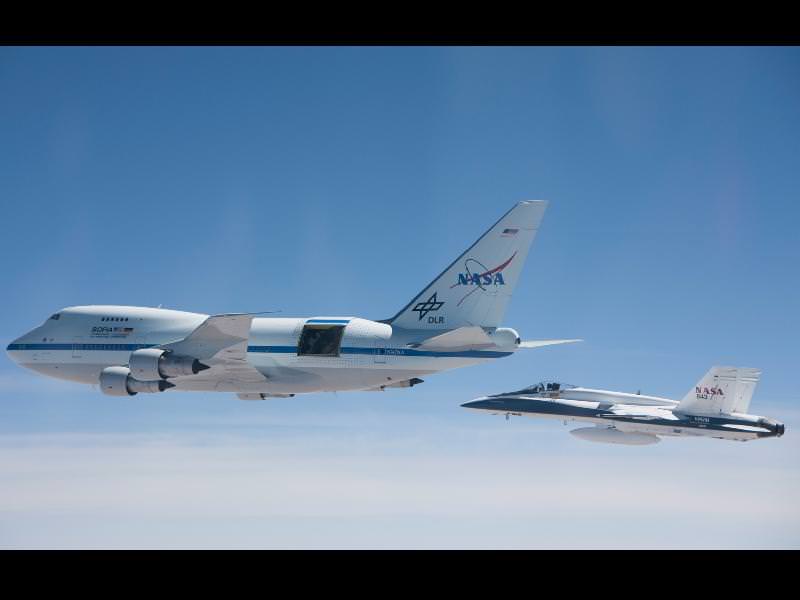[/caption]
Flying SOFIA has opened her eyes! The Stratospheric Observatory for Infrared Astronomy (SOFIA), a joint program by NASA and the German Aerospace Center made its first observations on May 26. The new observatory uses a modified 747 airplane to carry a German-built 2.5 meter (100 inch) reflecting telescope. “With this flight, SOFIA begins a 20-year journey that will enable a wide variety of astronomical science observations not possible from other Earth and space-borne observatories,” said Jon Morse, Astrophysics Division director in the Science Mission Directorate at NASA. “It clearly sets expectations that SOFIA will provide us with “Great Observatory”-class astronomical science.”
Scientists are now processing the first light data, and say that preliminary results show the sharp, “front-line” images that were predicted for SOFIA. They reported the stability and precise pointing of the German-built telescope met or exceeded the expectations of the engineers and astronomers who put it through its paces during the flight.

“The crowning accomplishment of the night came when scientists on board SOFIA recorded images of Jupiter,” said USRA SOFIA senior science advisor Eric Becklin. “The composite image from SOFIA shows heat, trapped since the formation of the planet, pouring out of Jupiter’s interior through holes in its clouds.”

Cornell University built the primary instrument on the telescope, the Faint Object infrared Camera for the SOFIA Telescope, also known as FORCAST. FORCAST is unique in that it records energy coming from space at infrared wavelengths between 5 and 40 microns – most of which cannot be seen by ground-based telescopes due to blockage by water vapor in Earth’s atmosphere. SOFIA’s operational altitude, which is above more than 99 percent of that water vapor, allows it to receive 80 percent or more of the infrared light accessible to space observatories, so FORCAST captures in minutes images that would require many hour-long exposures by ground-based observatories

The first light flight took off from SOFIA’s home base at the Aircraft Operations Facility in Palmdale, Calif., of NASA’s Dryden Flight Research Center. The in-flight personnel consisted of an international crew from NASA, the Universities Space Research Association in Columbia, Md., Cornell University and the German SOFIA Institute (DSI) in Stuttgart. During the six-hour flight, at altitudes up to 35,000 feet, the crew of 10 scientists, astronomers, engineers and technicians gathered telescope performance data at consoles in the aircraft’s main cabin.
Source: NASA


That should please our fellow commenter — DrFlimmer! 😉
What is not possible fron space-borne observatories?
HeadAroundU,
For those already up there, replenishment of the material that keeps the key parts cool enough for them to make deep astronomical observations – liquid helium, solid hydrogen, etc.
There’s also the fact that SOFIA has a larger primary mirror than all current space-based IR observatories, except Herschel (and the HST, but it’s not primarily an IR observatory).
Finally, new instruments can, relatively easily, be added to SOFIA, but no one can change what’s already up there for current space-based IR observatories (even the Hubble is now stuck with the instruments it’s got).
Not to mention that the space telescopes are stuck in the orbits they’re in. An aeroplane-mounted telescope has more freedom.
True, but the game changing JWST and her 6.5 m (21 ft) mirror isn’t far way.
Jon Morse describes SOFIA as being in the “Great Observatory” class. It is better to offer that opinion looking back on some unique and important results. After 14 years of self promotion, SOFIA has a lot to live up to.
The field of view from a heliocentric Earth trailing orbit or Earth-Moon-L2 orbit isn’t obstructed by the Earth to the same degree and isn’t restricted to night time viewing like SOFIA.
Very few objective questions are being asked here, particularly in regards to the aircraft such as….
How come the viewing hole wasn’t designed to let instruments see from both sides of the aircraft, that is to allow observing of the same object on the return leg of the flight?
How come L-3 Com took 10 years to modify N747NA originally built in only a few months?
If N747NA is to fly for the next 20 years, then why weren’t the modifications done at Boeing where it might have emerged with winglets and newer engines giving it far better range and fuel economy?
The more the build life time drags on across various administrations, the greater the likelihood of the project falling victim to changing priorities. An international partnership contract with DLR may have been a key factor saving SOFIA from cancellation.
It’s really is good to hear that SOFIA is finally up and running but let’s not overlook any lessons to be learnt from reviewing the project in clear day light.
TerryG,
The delays etc in getting SOFIA off the ground are, indeed, shocking and unfortunate.
However, the JWST will no more do SOFIA out of business than the HST did any large ground-based optical facility (e.g. Kecks, Geminis, VLT).
To take just one example, the largest field of view of either imager planned for the JWST is <10 square arcmins!
Why does it need a F18 fighter escort? Somebody might shoot down a telescope? O_o
@Jean Tate
Thanks in advance to yourself and UT for all the great upcoming articles about both.
Might we also be treated to a return of Jean Tate’s pre-print picks of week if we are lucky? 🙂
Oooh, pre-prints… om nom nom… eh, sorry, wrong category. [/retches]
I’m with TerryG on this, obviously.
Thanks for answering my question.